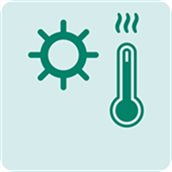Heat wave
Heat waves are prolonged periods of excessively high temperatures that can strain human and animal health, ecosystems, and infrastructure. They are becoming increasingly frequent and intense due to climate change, posing significant social and environmental challenges.
For details on heat waves and Dutch policies and regulations, insurances, datasets, and risk assessment methods, please visit the Heat stress page.
Internationally, a heat wave is often defined as ‘a period of abnormally hot weather often defined with reference to a relative temperature threshold, lasting from two days to months. Heatwaves and warm spells have various and, in some cases, overlapping definitions’. In the Netherlands, the Royal Netherlands Meteorological Institute (KNMI) has its own definition of a heat wave. For this, they use the weather station in De Bilt, where the Meteorological Institute is located. Their definition is as follows: ‘A heat wave is defined as a sequence of at least five consecutive summer days in De Bilt (with a maximum temperature of 25 °C or higher), of which at least three must be tropical days (with a maximum temperature of 30 °C or higher)’.
In the Netherlands, different types of hot days and nights are distinguished:
- Summer day: A day with a maximum temperature of 25 °C or higher.
- Tropical day: A day with a maximum temperature of 30 °C or higher.
- Extremely hot day: A day with a maximum temperature of 35 °C or higher.
- Tropical night: A night with a maximum temperature of 20 °C or higher.

